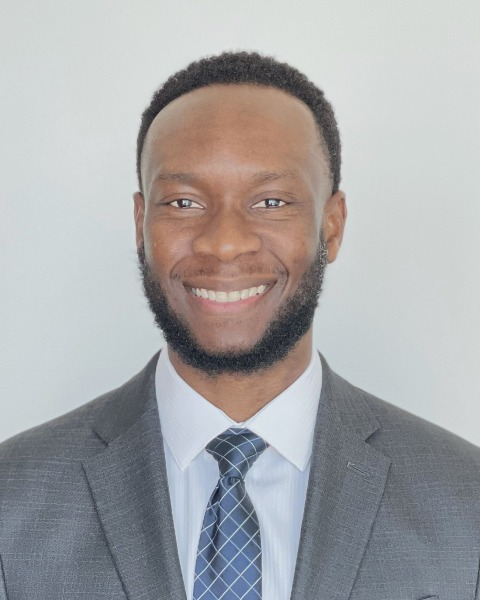Monday Poster Session
Category: Endoscopy Video Forum
P2728 - Successful Esophageal Reconstitution After Complete Obstruction Using an Endoscopic Rendezvous Technique With Biliary Stent Placement
Monday, October 27, 2025
10:30 AM - 4:00 PM PDT
Location: Exhibit Hall

Ikenna K. Emelogu, MD
University of Texas Southwestern Medical Center, TX
Presenting Author(s)
Award: ACG Presidential Poster Award
Ikenna K. Emelogu, MD, Simeng Wang, MD, Markus Goldschmiedt, MD, Thomas Tielleman, MD
University of Texas Southwestern Medical Center, Dallas, TX
Introduction: Refractory peptic strictures can lead to complete luminal obstruction in the esophagus in rare cases. Endoscopic management is challenging given the inability to directly access the lumen to allow for dilation. We present a case of esophageal reconstitution using an endoscopic rendezvous technique.
Case Description/
Methods: A 27-year-old man with a history of intellectual disability and refractory peptic stricture status post gastrostomy tube placement presented for EGD.
On exam, he was not tolerating any secretions. EGD showed a dilated and fluid-filled esophagus with a completely closed-off stenosis in the distal esophagus, preventing passage of a guidewire. A pediatric endoscope was advanced through the gastrostomy tract and was also unable to identify the lumen on the distal end of the stenosis. The case was discussed with Cardiothoracic Surgery, who felt that the patient was a poor surgical candidate. The decision was made to manage the obstruction endoscopically using a rendezvous technique.
An adult gastroscope was passed through the mouth to the level of the closed-off stenosis. A pediatric endoscope was passed through the patient's gastrostomy tract to allow for direct visualization from the distal esophagus. The two endoscopes were lined up on fluoroscopy. Under endoscopic and fluoroscopic guidance, the stiff end of a long 0.035-inch guidewire was passed through the gastroscope and used to puncture through the esophageal mucosa in the direction of the pediatric endoscope and the gastric lumen. The guidewire successfully passed into the stomach. The stenosis was dilated with a 10 mm biliary balloon dilator. Given the patient’s intellectual disability, nasogastric tube placement was not an option due to the risk of tube removal prior to mature tract formation. Therefore, the decision was made to place a metal biliary stent to maintain luminal patency. A 10 mm by 10 cm fully covered metal biliary stent equipped with anti-migration flaps was placed under endoscopic and fluoroscopic guidance. Endoscopic suturing was performed to further secure the stent in place with plans to upsize in 6-8 weeks after tract maturation.
Discussion: For patients with refractory peptic strictures that progress to complete obstruction, surgical evaluation may be necessary. However, for non-surgical candidates with a pre-existing gastrostomy tract, endoscopic management with rendezvous technique offers a viable option for palliation.
Disclosures:
Ikenna Emelogu indicated no relevant financial relationships.
Simeng Wang indicated no relevant financial relationships.
Markus Goldschmiedt indicated no relevant financial relationships.
Thomas Tielleman: ConMed – Consultant.
Ikenna K. Emelogu, MD, Simeng Wang, MD, Markus Goldschmiedt, MD, Thomas Tielleman, MD. P2728 - Successful Esophageal Reconstitution After Complete Obstruction Using an Endoscopic Rendezvous Technique With Biliary Stent Placement, ACG 2025 Annual Scientific Meeting Abstracts. Phoenix, AZ: American College of Gastroenterology.
Ikenna K. Emelogu, MD, Simeng Wang, MD, Markus Goldschmiedt, MD, Thomas Tielleman, MD
University of Texas Southwestern Medical Center, Dallas, TX
Introduction: Refractory peptic strictures can lead to complete luminal obstruction in the esophagus in rare cases. Endoscopic management is challenging given the inability to directly access the lumen to allow for dilation. We present a case of esophageal reconstitution using an endoscopic rendezvous technique.
Case Description/
Methods: A 27-year-old man with a history of intellectual disability and refractory peptic stricture status post gastrostomy tube placement presented for EGD.
On exam, he was not tolerating any secretions. EGD showed a dilated and fluid-filled esophagus with a completely closed-off stenosis in the distal esophagus, preventing passage of a guidewire. A pediatric endoscope was advanced through the gastrostomy tract and was also unable to identify the lumen on the distal end of the stenosis. The case was discussed with Cardiothoracic Surgery, who felt that the patient was a poor surgical candidate. The decision was made to manage the obstruction endoscopically using a rendezvous technique.
An adult gastroscope was passed through the mouth to the level of the closed-off stenosis. A pediatric endoscope was passed through the patient's gastrostomy tract to allow for direct visualization from the distal esophagus. The two endoscopes were lined up on fluoroscopy. Under endoscopic and fluoroscopic guidance, the stiff end of a long 0.035-inch guidewire was passed through the gastroscope and used to puncture through the esophageal mucosa in the direction of the pediatric endoscope and the gastric lumen. The guidewire successfully passed into the stomach. The stenosis was dilated with a 10 mm biliary balloon dilator. Given the patient’s intellectual disability, nasogastric tube placement was not an option due to the risk of tube removal prior to mature tract formation. Therefore, the decision was made to place a metal biliary stent to maintain luminal patency. A 10 mm by 10 cm fully covered metal biliary stent equipped with anti-migration flaps was placed under endoscopic and fluoroscopic guidance. Endoscopic suturing was performed to further secure the stent in place with plans to upsize in 6-8 weeks after tract maturation.
Discussion: For patients with refractory peptic strictures that progress to complete obstruction, surgical evaluation may be necessary. However, for non-surgical candidates with a pre-existing gastrostomy tract, endoscopic management with rendezvous technique offers a viable option for palliation.
Disclosures:
Ikenna Emelogu indicated no relevant financial relationships.
Simeng Wang indicated no relevant financial relationships.
Markus Goldschmiedt indicated no relevant financial relationships.
Thomas Tielleman: ConMed – Consultant.
Ikenna K. Emelogu, MD, Simeng Wang, MD, Markus Goldschmiedt, MD, Thomas Tielleman, MD. P2728 - Successful Esophageal Reconstitution After Complete Obstruction Using an Endoscopic Rendezvous Technique With Biliary Stent Placement, ACG 2025 Annual Scientific Meeting Abstracts. Phoenix, AZ: American College of Gastroenterology.


